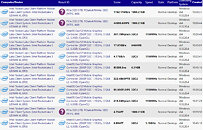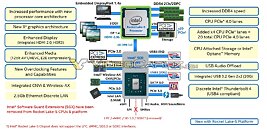- Joined
- Oct 9, 2007
- Messages
- 47,296 (7.53/day)
- Location
- Hyderabad, India
| System Name | RBMK-1000 |
|---|---|
| Processor | AMD Ryzen 7 5700G |
| Motherboard | ASUS ROG Strix B450-E Gaming |
| Cooling | DeepCool Gammax L240 V2 |
| Memory | 2x 8GB G.Skill Sniper X |
| Video Card(s) | Palit GeForce RTX 2080 SUPER GameRock |
| Storage | Western Digital Black NVMe 512GB |
| Display(s) | BenQ 1440p 60 Hz 27-inch |
| Case | Corsair Carbide 100R |
| Audio Device(s) | ASUS SupremeFX S1220A |
| Power Supply | Cooler Master MWE Gold 650W |
| Mouse | ASUS ROG Strix Impact |
| Keyboard | Gamdias Hermes E2 |
| Software | Windows 11 Pro |
Screenshots of a SiSoft SANDRA database submission of an alleged Intel 11th Gen Core "Rocket Lake-S" desktop processor machine confirms that the processor introduces PCI-Express gen 4.0 support to Intel's mainstream desktop platform. PCIe gen 4.0 has been rather limited in Intel's product stack, with only 10th Gen Core "Ice Lake-U" and "Ice Lake-Y" mobile processors supporting it so far. The upcoming 11th Gen "Tiger Lake" mobile processors will support it, too. Intel's HEDT product line, currently led by "Cascade Lake-X," as well as the server side of things, let by "Cooper Lake," are limited to PCIe gen 3.0. The SANDRA screenshot shows the "Rocket Lake-S" powered machine running a PCI-Express 4.0 NVMe SSD.
According to alleged "Rocket Lake-S" + Intel 500-series chipset platform maps leaked to the web by VideoCardz, "Rocket Lake-S" will finally take forward strides in the area of I/O. The CPU socket puts out not just its usual PEG slot (16 lanes meant for PCI-Express graphics cards), but also a CPU-attached M.2 NVMe slot with 4 PCI-Express gen 4.0 lanes, much like Socket AM4 motherboards based on AMD X570 or B550 chipsets. What's more, Intel fattened the chipset bus with 8 lanes. While the bus is still DMI 3.0 (with PCI-Express gen 3.0 physical layer), 8 lanes mean a doubling in bandwidth compared to Intel 400-series chipsets (or older). The 500-series PCH itself will still be PCI-Express gen 3.0 based, putting out only gen 3.0 downstream PCIe lanes, unlike the AMD X570, which puts out gen 4.0 downstream general purpose lanes, and uses a PCI-Express 4.0 x4 pipe to the CPU. Quite a few Intel 400-series chipset motherboards have preparation for PCIe gen 4.0 PEG slot when paired with a "Rocket Lake-S" processor.


View at TechPowerUp Main Site
According to alleged "Rocket Lake-S" + Intel 500-series chipset platform maps leaked to the web by VideoCardz, "Rocket Lake-S" will finally take forward strides in the area of I/O. The CPU socket puts out not just its usual PEG slot (16 lanes meant for PCI-Express graphics cards), but also a CPU-attached M.2 NVMe slot with 4 PCI-Express gen 4.0 lanes, much like Socket AM4 motherboards based on AMD X570 or B550 chipsets. What's more, Intel fattened the chipset bus with 8 lanes. While the bus is still DMI 3.0 (with PCI-Express gen 3.0 physical layer), 8 lanes mean a doubling in bandwidth compared to Intel 400-series chipsets (or older). The 500-series PCH itself will still be PCI-Express gen 3.0 based, putting out only gen 3.0 downstream PCIe lanes, unlike the AMD X570, which puts out gen 4.0 downstream general purpose lanes, and uses a PCI-Express 4.0 x4 pipe to the CPU. Quite a few Intel 400-series chipset motherboards have preparation for PCIe gen 4.0 PEG slot when paired with a "Rocket Lake-S" processor.


View at TechPowerUp Main Site






